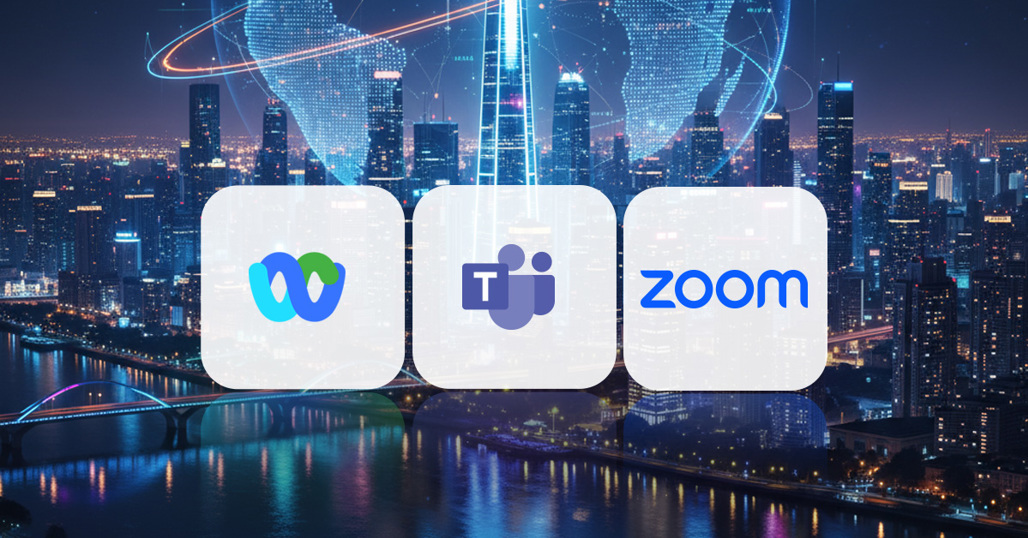Unified communications was supposed to simplify everything. One platform, one interface, one seamless experience. But in today’s enterprise reality, “unified” often looks more like “multiple”. Microsoft Teams, Webex and Zoom have become household names in the workplace – and many organizations are now running two or even all three simultaneously.

It’s not about indecision. As this article from TechRadar points out, it’s all about flexibility and using the right tools for the job.1 After all, one department may prefer Webex for its webinars, another relies on Zoom for external meetings, while IT has standardized on Teams for internal collaboration. Throw partner and customer preferences into the mix, along with mergers and acquisitions, and it’s easy to see how businesses have arrived at a multi-platform UC environment – whether they planned to or not.
So how do you make it all work?
The Cost of Fragmentation
Multi-platform UC can create some serious challenges. Users must juggle different interfaces, admins must manage multiple licensing models and IT teams are stuck with siloed analytics and overlapping infrastructure. What was supposed to drive productivity can quickly lead to confusion, inefficiencies and escalating costs.
Even more critically, voice services – especially PSTN connectivity – can become fragmented, leading to inconsistent call quality, compliance concerns and a poor user experience. On top of that, costs can quickly spiral due to inefficient routing plans, duplicate trunks across platforms and the excessive maintenance required to keep multiple systems running. To deliver a truly unified communications experience, therefore, businesses need to take control of the complexity.
One Core Infrastructure. Many Platforms.
The key is decoupling the UC platform from the underlying voice and network infrastructure. Instead of building separate environments for each platform, organizations can centralize their voice services, SIP trunking and security policies using a shared foundation – like a certified session border controller (SBC) or a hybrid voice solution in the cloud.
This approach offers multiple benefits:
- Consistency Across Platforms: Users get the same reliable PSTN connectivity, wherever they are and whichever platform they’re using.
- Simplified Management: IT gains a single point of control for provisioning, monitoring and troubleshooting.
- Better Economics: By consolidating infrastructure, organizations avoid duplication and can optimize license usage and carrier contracts.
A Strategic Role for Service Providers and Partners
This shift also opens up new opportunities for service providers and partners. As enterprises look for help managing complexity, telecommunications companies and UCaaS providers are well-positioned to step in with solutions for:
- Multi-UCaaS delivery and operation
- Certified PSTN connectivity for Microsoft Teams, Webex and Zoom
- Lifecycle management including provisioning, operation and analytics
- Value-added services for call recording, meeting productivity and contact centers
By offering platform-agnostic solutions, service providers and partners can help customers stay flexible – all while delivering the consistency, security and support they need to thrive.
How AudioCodes Can Help
AudioCodes is uniquely equipped to support organizations navigating multi-platform UC environments. Our market-leading certified Mediant SBCs, the innovative AudioCodes Live Platform and automation and management tools work across Microsoft Teams, Webex, Zoom and beyond.
Whether you’re a service provider enabling customers with hosted voice or an enterprise IT leader seeking a scalable, future-proof foundation, AudioCodes can help you deliver high-quality PSTN voice across platforms, centralize control and monitoring for greater visibility and automate provisioning to significantly reduce operational burden.
In addition, we can also help you extend the value of your voice infrastructure with AI-powered value-added services for deeper insights, greater productivity and smarter workflows across your entire communications landscape.
Unified, Not Uniform
In reality, the future of UC is multi-platform. But that doesn’t mean it has to be fragmented. With the right strategy and supporting infrastructure, businesses can embrace choice without sacrificing control. And with a trusted partner like AudioCodes, they can turn complexity into opportunity.
